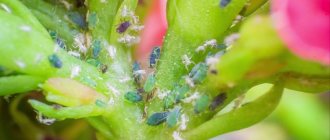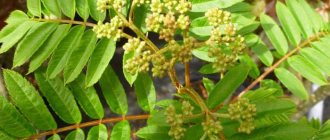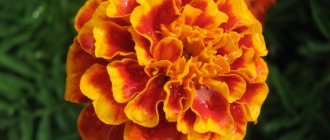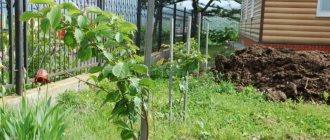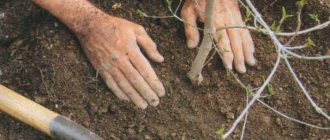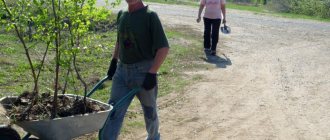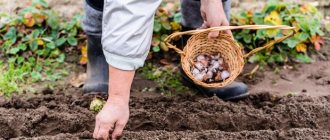Aster is a floral herbaceous crop from the Latin word Aster - a genus of herbaceous plants of the Asteraceae family, numbering more than two hundred species of the most varied colors. It has long been a widely known favorite flower crop, whose amazingly beautiful inflorescences-baskets give any flower garden a festive, elegant look. The Latin name of this plant comes from its Greek version “άστήρ”, which means star. Indeed, according to the flower rating of beauty and ease of care when growing it, it is a real star of the flower bed.
For your information! According to the latest scientific data, the flower culture "garden aster" and "Chinese aster" - annual asters - are classified as related to Callistephus. Now it is correct to call just such an aster Chinese Callistephus (Callistephus chinensis). But no matter what you call beauty, it will remain beauty. The asters that have reached their maximum color by the end of summer are very picturesque - just a carnival of bouquets of indescribable color and shape.
- How to sow an aster before winter in open ground
- Pros and cons of sowing aster before winter
- How to prepare a place for autumn sowing of aster
- How to fertilize the soil for autumn sowing of aster
- When and how to sow aster seeds before winter?
- Gardening tips
And although it is generally accepted that this flower culture is unpretentious, capable of growing even in partial shade and withstanding temperature zigzags, it really loves fertilizing and periodic watering and thanks for their sufficiency with the bright and lush flowering of unrealistically beautiful flowers. The aster blooms for a long time, until the first frost, but cannot survive more than -3 C, although it is considered a cold-resistant plant.
But its seeds can withstand even frosts, which gives it the opportunity, under certain conditions, to reproduce even by self-sowing, especially sowing aster before winter - nothing is simpler, especially for those who already have experience in this activity and know how to sow flower seeds before winter in open ground.
On my site, thanks, of course, to the southern climate and the fact that I don’t dig up the aster flower bed in the fall, but only pull out dried plants and weeds, with the sowing and seedlings of “callistephus aster”, its annual crop, in the spring there is only one problem : what to do with this meadow of self-seeded aster. And this despite the fact that self-seeding is not covered with soil - as it is sown, it remains until spring. Of course, I let it grow and after rain or heavy watering I thin out some of it, and carefully pull out the rest and distribute it to neighbors on the dacha street.
Pros and cons of sowing aster before winter
An undeniable advantage of winter sowing of aster is its instability to a dangerous fungal disease - Fusarium rot or Fusarium wilt. When this type of fungus infects flowering asters, the buds begin to fade, and the disease itself begins with yellowing of the leaves of the lower part of the plant, which turn black on one side or become covered with spots. It is the winter sowing of this crop that leads to a significant or complete elimination of this disease.
Annual asters sown in winter, hardened by winter vegetation conditions, bloom two to three weeks earlier than those sown in the spring.
- Autumn sowing of seeds saves the grower's time in that he does not spend it in the hot spring growing aster seedlings.
- Aster seeds that have overwintered in the soil undergo the hardening necessary for active growth, acquiring natural immunity against many diseases.
- Plants from such sowing develop resistance to temperature changes, and the seeds are more germinating, despite their natural loss.
A conditional disadvantage can only be attributed, as many gardeners say, to a certain high cost of the number of seeds when sowing them before winter.
Spring care
When the snow melts, if film was used, remove it. Some summer residents advise covering with plant debris, some do not.
Seedlings that begin to emerge from the ground need plenty of sunlight. The gardener has the right to decide for himself what to do. If the plantings are not covered, then the gardener needs to monitor the weather forecast. During frosts, cover the sprouts to prevent them from being damaged by frost.
When consistently warm weather sets in, the seedlings are thinned out. Since the seeds are planted more densely than during spring planting, the excess ones must be removed.
Thinned flowers will grow faster. They will form a strong root system, the key to a well-developed above-ground part and abundant flowering. Water the sprouts as needed. Not forgetting that aster does not like excess moisture. They begin to rot. But the soil should not dry out either. It is necessary to monitor the humidity level. To preserve moisture, loosen the soil. In addition, it reduces the number of weeds, which also interfere with the proper development of plants.
Treatment for diseases
Aster, like other plants, is often attacked by viruses and fungi. Compliance with agricultural practices significantly reduces the risk of diseases in plants.
If signs of disease appear, it is necessary to immediately treat with special preparations. They are purchased in stores. Summer residents treat asters with chemicals without fear, as it has an effective effect and relieves diseases for a long time.
Use chemicals with caution if fruit and vegetable crops grow nearby. Especially if spraying is carried out
Compliance with planting requirements helps avoid the occurrence of diseases.
Feeding
Young, immature plants require fertilization
It is important to remember that it is better to underfeed than to overfeed
In spring add to the soil:
There is no need to add organic matter, since it is added in sufficient quantities when forming beds in the fall. Planting aster before winter helps many gardeners. Following the recommendations and techniques of agricultural technology will allow you to get a flowering flowerbed several weeks ahead of schedule.
How to prepare a place for autumn sowing of aster
It is important to choose exactly the place where, after thinning out the seedlings in the spring, the rest of the plants can be allowed to grow until autumn without diving, so that they will turn out to be very lush asters blooming with maximum color, size and beauty.
The place should have good drainage so that the seeds do not get wet in early spring.
The best place may be a flowerbed with full daylight sunlight, but partial shade is also allowed, in which the plants will stretch out a little, but will bloom just as profusely as in the sun.
Marigolds and calendula are considered acceptable predecessors for aster. Undesirable ones include tulips, carnations and last year's aster itself.
How to fertilize the soil for autumn sowing of aster
The future flower bed for winter sowing of annual aster is deeply dug and loosened, thereby enriching it with oxygen and improving the soil structure - this, by the way, is one of the main tasks of autumn digging of soil in the garden. The soil should have a minimum acidity level.
When digging, you can add potassium sulfate and superphosphate as autumn fertilizers. Humus is applied at the rate: 3 kilograms per 1 square meter. Experienced gardeners intensify the fight against fusarium fungus spores by burning a fire with plant and other organic waste on the site of the future flower bed with asters. Warming the soil under the fire will serve as disinfection, and the remaining ashes will serve as organic fertilizer.
On a leveled flower bed, make grooves two centimeters deep and cover it in this form with waterproof material, securing it along the edges with pebbles from the wind, until the required cold degrees arrive. And dry soil is stored in a waterproof bag for subsequent mulching of the crops themselves.
Preparing perennial flowers for winter
If there are perennial representatives of the family in the garden, do not forget about preparing them for the winter period. If everything is done correctly, the plants will delight you with abundant flowering next year.
How to trim
Summer residents are wondering whether it is possible to prune perennial asters. Experienced flower growers advise making sure to carry out pruning. You need to wait until the stems dry out. Most often this happens after the first severe frost. Then cut them at a height of 2-5 cm from the ground. Sawdust is used to cover varieties that do not tolerate frost, as well as young bushes.
Fertilizers
An important stage in preparing plants for winter is fertilizing. Before wintering, the plant collects more nutrients from the soil. It is necessary to add organic matter or complex fertilizer. Flower growers recommend feeding perennial asters with wood ash. 0.2-0.3 kg of the substance is distributed around the plants, then the soil is loosened.
When and how to sow aster seeds before winter?
The optimal answer to when and how to sow aster before winter in open ground will be determined by the weather. It should be dry and slightly frosty. Around the end of November - beginning of December.
First, the covering material is removed. Absolutely dry, thicker annual aster seeds that have not been soaked at all are sown in prepared grooves, taking into account that some of them will fall off naturally for various reasons.
The furrows filled with seed are filled with prepared dry soil so that it rises 2-3 centimeters above the furrows. There is no need to water the crops - they will be cooler with water
At the end of such sowing before winter, all that remains is to insulate the flowerbed with suitable mulch and even spunbond, after laying down the spruce branches.
Stages of winter planting of asters
The recommendations of experienced gardeners are strictly followed. Otherwise, the summer resident risks being left without seeds and flowers.
Preparing the site and soil
It is advisable to choose a site where the asters will be illuminated by the sun most of the day.
Then the selected area is dug up, adding the following components:
- peat;
- superphosphate;
- urea;
- potassium;
- wood ash;
- river sand.
The soil is dug up to a depth of 25 cm, grooves are immediately formed and the bed is covered until the onset of persistent cold weather.
The soil for filling the furrows is collected in advance. Place in a dry place, the structure should be crumbly. Because in the spring, when the sprouts begin to emerge, the crust over the bed will not allow them to germinate.
Sowing
Planting of seeds is carried out within the allotted time depending on the region of residence of the grower. Planting material is laid out along the grooves and sprinkled with prepared soil. The planting depth is 2-2.5 m. You need to sow asters correctly in winter. Seeds are planted frequently. In the spring, after the emergence of seedlings, the seedlings are thinned out. Excess planting material is not thrown away. It is used for planting elsewhere.
Shelter for the winter
The plantings are covered with polyethylene, pressed down at the edges and left until the thaw in the spring. Then the cover is removed and covered with dry plant debris. They are not removed until consistently warm weather arrives.
Gardening tips
After the aster has been sowed before winter in the open ground, stakes should be inserted so as not to harm the sprouts that have already started but are not yet visible in the spring. On such poles you can write the varieties of sown plants.
Be sure to fill the grooves with seeds with loose soil without any compaction, so that the sprouts do not waste energy on difficult germination.
When the sprouts emerge in the spring, we hope, amicably, do not rush to remove the excess ones by thinning. They will not have time to cause significant damage to the fertility of the flowerbed, but you will have the opportunity to choose and keep the most ideal specimens of them, which can be sold or donated and, perhaps, there will be a place for some of them in different parts of the plot, but from the second half of summer they They will decorate it with bright spots and delight the eye.
In dry spring conditions, it is very important to provide seedlings of the moisture-loving aster with moderate and regular watering, without relying only on winter soil moisture recharging, especially when there is a shortage of natural precipitation.
When it is necessary to thin out aster seedlings, it is necessary to leave the interval between plants taking into account the width of an adult plant, approximately 20-30 centimeters between them, which will allow the development of powerful bushes with beautiful and full-fledged flowers and will make your flowerbed or flower garden even more beautiful and pleasant.
If for some reason you receive rare aster shoots, and this will be visible in early spring, you still have time for overseeding according to the well-known rules for spring sowing of flower seeds. You should not be overzealous with early fertilizing, given that even when sowing you added a sufficient amount of mineral fertilizers and certain types of organic fertilizers, for example, humus. When objectively assessing the condition of the seedlings—they look weakly green and thin—apply a minimum amount of nitrogen fertilizer in an aqueous solution so as not to overdo it and burn the tender aster seedlings. Many gardeners have their own useful experience in growing healthy asters by sowing before winter, but we still hope that with us you have found at least something useful for yourself and learned more about how to sow an aster.
